When NASA started a countdown to the release of the first colour images from the James Webb Space Telescope, it was a clear signal that the new cosmic views would be impressive. The history of images in science, however, has sometimes been a vexed one. Scientists have worried that visual representations might muddy or overshadow data-driven results. And while NASA eagerly curries positive attention, it remains extremely wary of bad press, especially around a much-delayed, far-over budget project such as the Webb. The agency wouldn’t have amped up the anticipation unless it had absolute confidence that it could show off something spectacular.
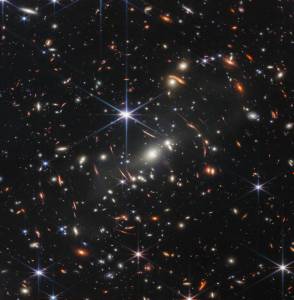
Webb’s First Deep Field, an image of galaxy cluster SMACS 0723. Image: NASA, ESA, CSA, and STScI
The vivid, highly detailed pictures unveiled on 12 July did not disappoint. Thousands of distant, tiny galaxies speckle Webb’s First Deep Field, while five comparatively nearby examples swirl together in Stephan’s Quintet. An intricate nimbus surrounds the remnants of a dying star in the Southern Ring Planetary Nebula. A portion of the Carina Nebula reveals the complex geography of a star-birthing region. The Webb images were worthy of superlatives. Here was the cosmos, inhumanly vast in size and scale, yet visible to us and better than we’d ever seen it before.
The public countdown began only a month before NASA shared the Webb images, but decades of experience with Hubble images shaped the agency’s preparation. It became common practice to celebrate milestones in the Hubble’s history, such as the installation of a new camera or the anniversary of its launch, with the release of a new images. Webb’s first observations have followed this model and had two goals: to demonstrate that the instrument was ready for scientific research and to excite the public imagination. By early 2020, NASA administrators and astronomers had generated a list of 70 possible celestial objects and regions for Webb’s initial public-facing images.
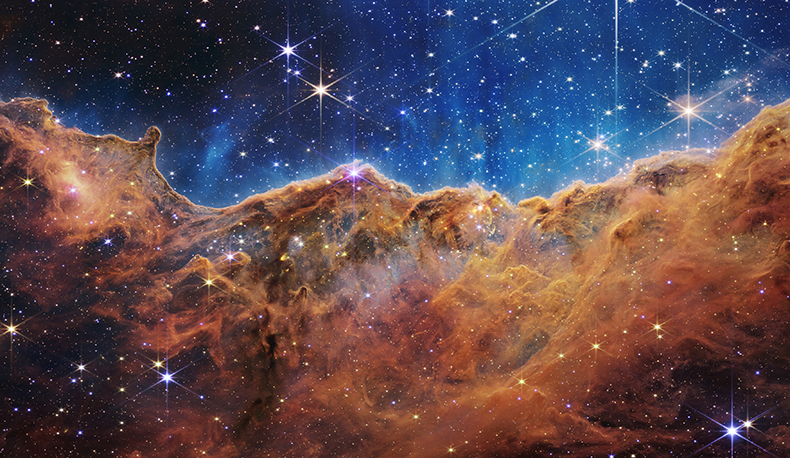
The Carina Nebula recorded by the James Webb Telescope. Image: NASA, ESA, CSA and STScI
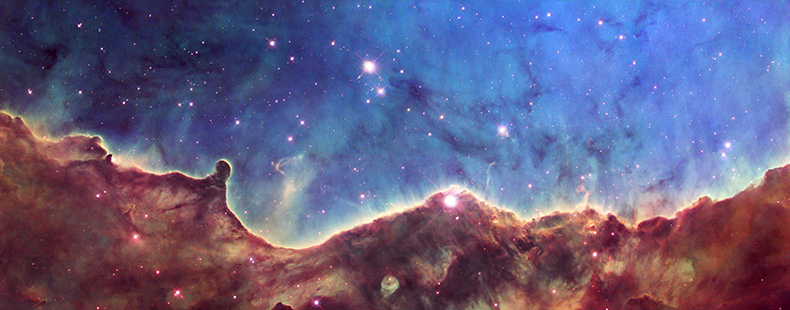
The Hubble Space Telescope’s image of the Carina Nebula (NGC 3372). Image: NASA, ESA and the Hubble Heritage Team (STScl/AURA)
For astronomy fans, the first Webb images depicted recognisable scenes. The Hubble had previously observed Stephan’s Quintet, the Southern Ring, and the same region of the Carina Nebula, and its Deep Field and Ultra Deep Field are among its most admired images. The return to well-known celestial objects set up a comparison that efficiently demonstrated Webb’s enhanced vision. To view the Hubble’s Carina Nebula alongside the Webb’s version implies a question familiar to anyone who has visited the eye doctor. Which one is better: number 1? Or number 2? The choice is obvious.
But the Webb offers more than sharper detail; it delivers new and improved vision. The telescope registers infrared light, light that lies beyond the Hubble’s reach, and far beyond that of the human eye. Webb’s images represent technologically enhanced sight made possible through advanced optics, cameras, and image-processing algorithms.
While working data from the Hubble and other powerful ground-based telescopes, astronomers and image processors have developed conventions for how to translate such radically enhanced vision into legible and culturally resonant images. Colour, for example, signifies physical properties, most often the relative wavelengths recorded by the three or more exposures required to create a full colour picture. Blue typically corresponds to shortest wavelength of light, red to longest, and green to the wavelength that falls in the middle. In addition, the resulting colour palette suggests we could see as the Webb does. When looking at Stephan’s Quintet or the Southern Ring, one might imagine a technologically sophisticated future in which humans fly by and snap a picture that looks just like these.
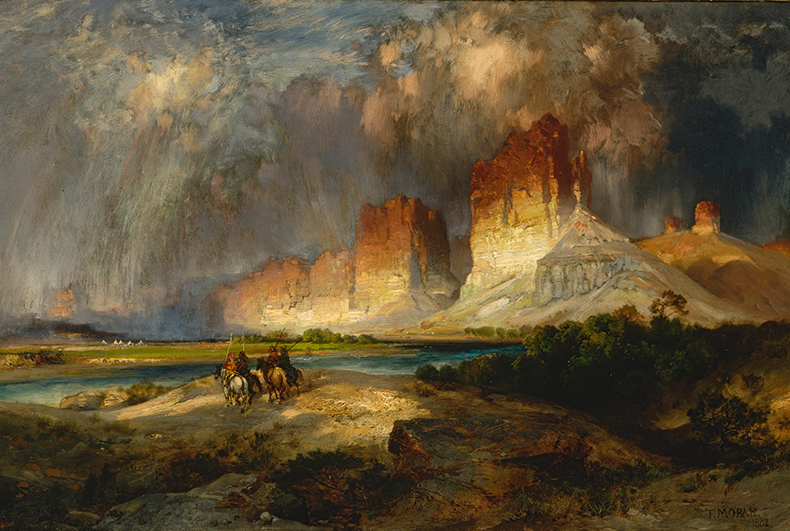
Cliffs of the Upper Colorado River, Wyoming Territory (1882), Thomas Moran, Smithsonian American Art Museum, Washington, D.C.
The colour palette and composition in Webb’s Carina Nebula take this sense of familiarity a step further, and the scene recalls paintings and photographs of earthly landscapes, an association underscored by NASA’s choice to label it the ‘Cosmic Cliffs’. The Webb image (and Hubble’s before it) frames and orients a small section of the nebula such that the gaseous clouds – shown in browns, oranges, and dark reds – resemble a craggy, mountainous vista with a blue, star-filled sky above. As I argue in my book, Picturing the Cosmos (2012), many Hubble images similarly and deliberately resemble landscapes, especially as depicted in 19th-century paintings of the American West by artists such as Thomas Moran and Albert Bierstadt. NASA likened the Hubble’s best-known image, the Pillars of Creation in the Eagle Nebula, to buttes in the American Southwest. By visually and rhetorically referring to these landscapes, astronomical images tap into the aesthetics of the sublime. They establish an analogy between the dramatic, awe-inspiring earthy cliffs and canyons and cosmic ones. In doing so, the Hubble images and now those from the Webb emphasise the vast size and scale of their subject matter. Such depictions of immensity remind us of humanity’s relative insignificance, as well as invite us to reach beyond our limits, to transcend the everyday and the mundane.
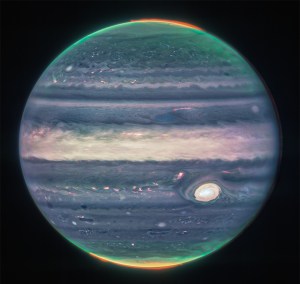
A composite image of Jupiter taken by the James Webb Space Telescope’s Near-Infrared Camera (NIRCam). Image: NASA, ESA, CSA, Jupiter ERS Team; image processing by Judy Schmidt
Subsequent Webb images – a startling blue version of Jupiter with radiant yellows poles and an eerie close-up of the Phantom Galaxy’s glowing centre – suggest other aesthetic possibilities that shift attention the Webb’s new, even disorienting, way of seeing. But its first images were comparatively conservative in their appearance. A long-anticipated and much-watched unveiling is not an auspicious moment for image-processing experiments. But maybe there’s another and timelier motivation as well. Through their evocation of the sublime, Webb images offer an other-worldly respite. In an era, when we are dogged by disease, economic uncertainty, political instability, and climate catastrophes, all of which threaten to overwhelm us, they remind us once again of the possibility of transcendence.
Elizabeth A. Kessler is the author of Picturing the Cosmos: Hubble Space Telescope Images and the Astronomical Sublime (University of Minnesota Press).

With the James Webb Telescope, star-gazing has become even more sublime
The heart of M74, otherwise known as the Phantom Galaxy, recorded by the James Webb Telescope. © ESA/Webb, NASA & CSA, J. Lee and the PHANGS-JWST Team
Share
When NASA started a countdown to the release of the first colour images from the James Webb Space Telescope, it was a clear signal that the new cosmic views would be impressive. The history of images in science, however, has sometimes been a vexed one. Scientists have worried that visual representations might muddy or overshadow data-driven results. And while NASA eagerly curries positive attention, it remains extremely wary of bad press, especially around a much-delayed, far-over budget project such as the Webb. The agency wouldn’t have amped up the anticipation unless it had absolute confidence that it could show off something spectacular.
Webb’s First Deep Field, an image of galaxy cluster SMACS 0723. Image: NASA, ESA, CSA, and STScI
The vivid, highly detailed pictures unveiled on 12 July did not disappoint. Thousands of distant, tiny galaxies speckle Webb’s First Deep Field, while five comparatively nearby examples swirl together in Stephan’s Quintet. An intricate nimbus surrounds the remnants of a dying star in the Southern Ring Planetary Nebula. A portion of the Carina Nebula reveals the complex geography of a star-birthing region. The Webb images were worthy of superlatives. Here was the cosmos, inhumanly vast in size and scale, yet visible to us and better than we’d ever seen it before.
The public countdown began only a month before NASA shared the Webb images, but decades of experience with Hubble images shaped the agency’s preparation. It became common practice to celebrate milestones in the Hubble’s history, such as the installation of a new camera or the anniversary of its launch, with the release of a new images. Webb’s first observations have followed this model and had two goals: to demonstrate that the instrument was ready for scientific research and to excite the public imagination. By early 2020, NASA administrators and astronomers had generated a list of 70 possible celestial objects and regions for Webb’s initial public-facing images.
The Carina Nebula recorded by the James Webb Telescope. Image: NASA, ESA, CSA and STScI
The Hubble Space Telescope’s image of the Carina Nebula (NGC 3372). Image: NASA, ESA and the Hubble Heritage Team (STScl/AURA)
For astronomy fans, the first Webb images depicted recognisable scenes. The Hubble had previously observed Stephan’s Quintet, the Southern Ring, and the same region of the Carina Nebula, and its Deep Field and Ultra Deep Field are among its most admired images. The return to well-known celestial objects set up a comparison that efficiently demonstrated Webb’s enhanced vision. To view the Hubble’s Carina Nebula alongside the Webb’s version implies a question familiar to anyone who has visited the eye doctor. Which one is better: number 1? Or number 2? The choice is obvious.
But the Webb offers more than sharper detail; it delivers new and improved vision. The telescope registers infrared light, light that lies beyond the Hubble’s reach, and far beyond that of the human eye. Webb’s images represent technologically enhanced sight made possible through advanced optics, cameras, and image-processing algorithms.
While working data from the Hubble and other powerful ground-based telescopes, astronomers and image processors have developed conventions for how to translate such radically enhanced vision into legible and culturally resonant images. Colour, for example, signifies physical properties, most often the relative wavelengths recorded by the three or more exposures required to create a full colour picture. Blue typically corresponds to shortest wavelength of light, red to longest, and green to the wavelength that falls in the middle. In addition, the resulting colour palette suggests we could see as the Webb does. When looking at Stephan’s Quintet or the Southern Ring, one might imagine a technologically sophisticated future in which humans fly by and snap a picture that looks just like these.
Cliffs of the Upper Colorado River, Wyoming Territory (1882), Thomas Moran, Smithsonian American Art Museum, Washington, D.C.
The colour palette and composition in Webb’s Carina Nebula take this sense of familiarity a step further, and the scene recalls paintings and photographs of earthly landscapes, an association underscored by NASA’s choice to label it the ‘Cosmic Cliffs’. The Webb image (and Hubble’s before it) frames and orients a small section of the nebula such that the gaseous clouds – shown in browns, oranges, and dark reds – resemble a craggy, mountainous vista with a blue, star-filled sky above. As I argue in my book, Picturing the Cosmos (2012), many Hubble images similarly and deliberately resemble landscapes, especially as depicted in 19th-century paintings of the American West by artists such as Thomas Moran and Albert Bierstadt. NASA likened the Hubble’s best-known image, the Pillars of Creation in the Eagle Nebula, to buttes in the American Southwest. By visually and rhetorically referring to these landscapes, astronomical images tap into the aesthetics of the sublime. They establish an analogy between the dramatic, awe-inspiring earthy cliffs and canyons and cosmic ones. In doing so, the Hubble images and now those from the Webb emphasise the vast size and scale of their subject matter. Such depictions of immensity remind us of humanity’s relative insignificance, as well as invite us to reach beyond our limits, to transcend the everyday and the mundane.
A composite image of Jupiter taken by the James Webb Space Telescope’s Near-Infrared Camera (NIRCam). Image: NASA, ESA, CSA, Jupiter ERS Team; image processing by Judy Schmidt
Subsequent Webb images – a startling blue version of Jupiter with radiant yellows poles and an eerie close-up of the Phantom Galaxy’s glowing centre – suggest other aesthetic possibilities that shift attention the Webb’s new, even disorienting, way of seeing. But its first images were comparatively conservative in their appearance. A long-anticipated and much-watched unveiling is not an auspicious moment for image-processing experiments. But maybe there’s another and timelier motivation as well. Through their evocation of the sublime, Webb images offer an other-worldly respite. In an era, when we are dogged by disease, economic uncertainty, political instability, and climate catastrophes, all of which threaten to overwhelm us, they remind us once again of the possibility of transcendence.
Elizabeth A. Kessler is the author of Picturing the Cosmos: Hubble Space Telescope Images and the Astronomical Sublime (University of Minnesota Press).
Unlimited access from just $16 every 3 months
Subscribe to get unlimited and exclusive access to the top art stories, interviews and exhibition reviews.
Share
Recommended for you
Return to the source – the invention of American landscape painting
The painters of the Hudson River School are now firmly recognised as pioneers of American art – and inspiring a new generation of artists
Crater glory – how artists have responded to Earth’s nearest neighbour
From Friedrich Nerly to Robert Rauschenberg – artistic fascination with the moon has never waned
Who is responsible for heritage in outer space?
A new international agreement raises questions about what counts as cultural property in space, how it should be protected and who should do the protecting